Did you know that the most powerful country in the world isn’t just defined by its military might? In fact, power comes from a mix of military strength, economic influence, and the ability to shape global events.
As of 2025, the United States is widely considered the most powerful nation, and this is not just because of its vast military forces.
The U.S. has the world’s largest economy, advanced technological innovations, and a global network of strategic partnerships that give it significant influence on the global stage.
However, which country comes in the 2nd or 3rd position? Curious to know? In this article, we’ll take a closer look at the top 10 most powerful countries in the world today.
Whether it’s the size of their armies or their ability to shape global policies, each country’s power is built on many different factors that make them key players in world affairs.
See More| What is ATACMS Missile? Know All About US-made Long-Range Missile Used by Ukraine to Strike Russia
List of the Most Powerful Countries in the World in 2025
Here's the list of the most powerful countries in the world in 2025, which includes major players such as the United States, China, and Russia. These countries possess significant military, economic, and political influence on a global scale. The list includes:
| Rank | Country | Best Countries Overall | GDP (USD) | GDP per Capita (PPP) | Population |
|---|---|---|---|---|---|
| 1 | United States | #3 | $27.4 trillion | $81,695 | 335 million |
| 2 | China | #16 | $17.8 trillion | $24,558 | 1.41 billion |
| 3 | Russia | #36 | $2.02 trillion | $44,104 | 144 million |
| 4 | United Kingdom | #8 | $3.34 trillion | $58,906 | 68.4 million |
| 5 | Germany | #7 | $4.46 trillion | $69,338 | 84.5 million |
| 6 | South Korea | #18 | $1.71 trillion | $54,033 | 51.7 million |
| 7 | France | #12 | $3.03 trillion | $61,157 | 68.2 million |
| 8 | Japan | #2 | $4.21 trillion | $50,207 | 125 million |
| 9 | Saudi Arabia | #32 | $1.07 trillion | $54,992 | 36.9 million |
| 10 | Israel | #46 | $510 billion | $53,434 | 9.76 million |
| 12 | India | #33 | $3.55 trillion | $10,176 | 1.43 billion |
Source: USA News
1. United States of America

-
Capital: Washington, D.C.
-
Region: North America
-
GDP: $27.4 trillion
-
GDP Per Capita (PPP): $81,695
-
Population: 334,914,895
-
Area: 9,833,517 sq. km
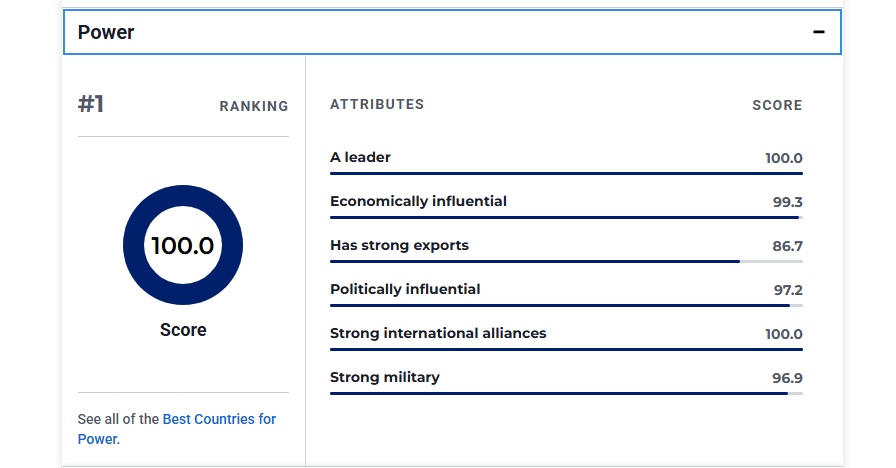
- Economic Power: The U.S. has the largest economy globally, with a nominal GDP of $30.34 trillion in 2025. It dominates industries such as technology, healthcare, aerospace, and finance. Silicon Valley drives innovation in AI and biotechnology, while New York remains the financial hub of the world.
- Military Strength: The U.S. leads in defence spending, with advanced weaponry and a global military presence. Its nuclear arsenal, extensive naval fleet, and strategic alliances through NATO solidify its dominance. The country also invests significantly in cyber warfare and space-based defence systems.
- Technological Advancements: The U.S. is at the forefront of AI, biotechnology, quantum computing, and space exploration. Companies like Google, Tesla, and SpaceX push boundaries in innovation, while NASA continues to lead global space missions.
2. China
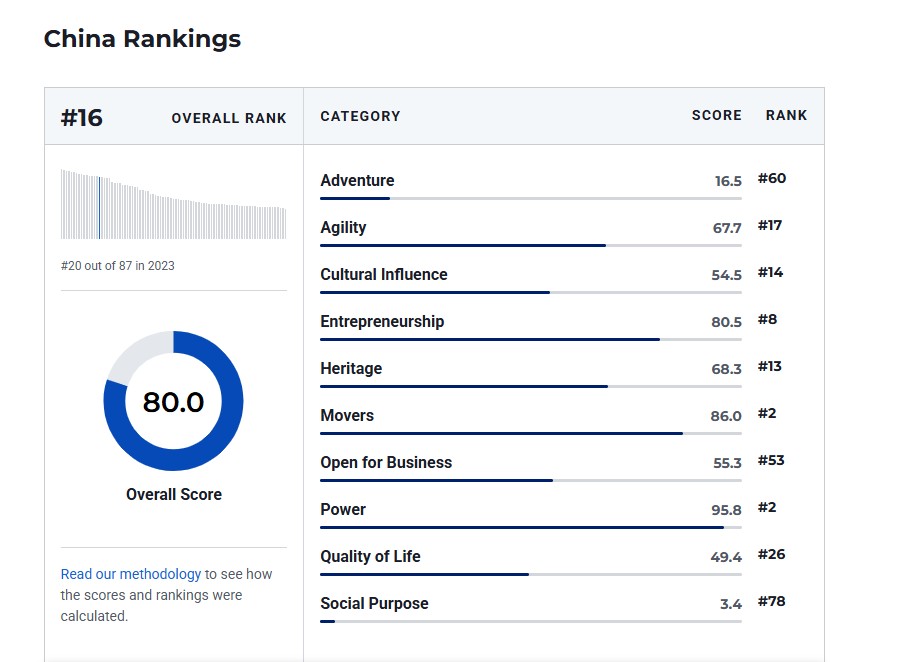
-
Capital: Beijing
-
Region: Asia
-
GDP: $17.8 trillion
-
GDP Per Capita (PPP): $24,558
-
Population: 1,410,710,000
-
Area: 9,596,960 sq. km
-
Economic Power: China is the second-largest economy globally ($19.53 trillion nominal GDP). It excels in manufacturing and exports, producing everything from electronics to green energy solutions. Investments in infrastructure projects like the Belt and Road Initiative further bolster its economic influence.
-
Military Strength: China has the largest standing army globally and is rapidly modernising its military capabilities. It possesses advanced missile systems, stealth aircraft, and naval assets such as aircraft carriers. Cyber warfare capabilities are also a key focus.
-
Technological Advancements: China leads in 5G networks, AI research, electric vehicles (e.g., BYD), and renewable energy technologies. Companies like Huawei dominate global telecommunications markets.
3. Russia

-
Capital: Moscow
-
Region: Asia
-
GDP: $2.02 trillion
-
GDP Per Capita (PPP): $44,104
-
Population: 143,826,130
-
Area: 17,098,242 sq. km
-
Economic Power: Russia’s economy ($4.74 trillion PPP) relies heavily on energy exports like oil and gas. Despite sanctions, it remains influential due to its vast natural resources and strategic partnerships.
-
Military Strength: Russia possesses one of the most powerful nuclear arsenals alongside advanced missile systems like S-400s and hypersonic weapons. Its cyber capabilities are among the most sophisticated globally.
-
Technological Advancements: Russia focuses on aerospace technologies via Roscosmos and defense innovations such as stealth aircraft and unmanned vehicles.
4. United Kingdom
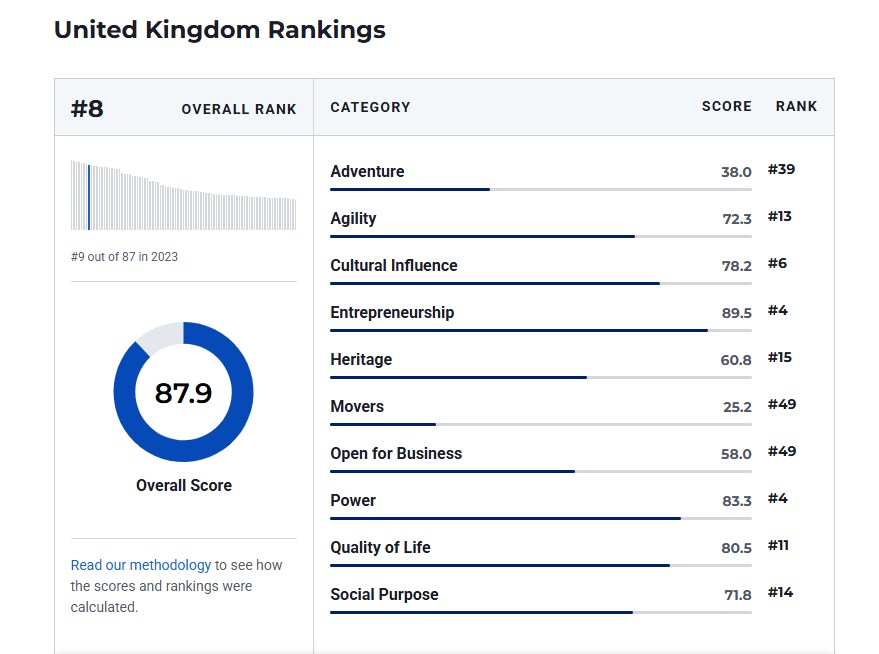
-
Capital: London
-
Region: Europe
-
GDP: $3.34 trillion
-
GDP Per Capita (PPP): $58,906
-
Population: 68,350,000
-
Area: 243,610 sq. km
-
Economic Power: The UK’s economy ($3.3 trillion nominal GDP) thrives on services like banking (e.g., HSBC) and insurance alongside industries like pharmaceuticals (e.g., AstraZeneca).
-
Military Strength: The UK has modernized armed forces with nuclear capabilities through Trident submarines and a strong naval presence globally.
-
Technological Advancements: The UK excels in AI research, fintech innovation, digital health technologies, and renewable energy projects.
5. Germany

-
Capital: Berlin
-
Region: Europe
-
GDP: $4.46 trillion
-
GDP Per Capita (PPP): $69,338
-
Population: 84,482,267
-
Area: 357,022 sq. km
-
Economic Power: Germany’s nominal GDP stands at $4.92 trillion (PPP $6.17 trillion). It is Europe’s largest economy with strengths in automotive engineering (e.g., BMW), chemicals (e.g., BASF), and machinery exports.
-
Military Strength: Germany maintains moderate military capabilities but invests heavily in NATO collaborations for collective defense.
-
Technological Advancements: Germany leads in industrial automation, renewable energy technologies (e.g., wind turbines), and advancements in AI applications for manufacturing.
#6. South Korea

- Capital: Seoul
- Region: Asia
- GDP (Purchasing Power Parity): $1.71 trillion
- GDP Per Capita (PPP): $54,033
- Population: 51,712,619
- Area: 99,720 sq. km
- Economic Power: South Korea's nominal GDP stands at $1.95 trillion, with a PPP GDP of $3.39 trillion, ranking 12th globally. The nation is a leader in semiconductors, holding 17.7% of the global market and over 60% in memory chips. Major industries include automotive, shipbuilding, and consumer electronics, powered by global firms like Samsung, Hyundai, and SK Hynix.
- Military Strength: South Korea allocates $46.7 billion to defense, or 2.32% of GDP, with 555,000 active personnel and 2.75 million reserves. Its arsenal includes 2,200+ tanks, 1,500+ aircraft, and 22 submarines. Advanced weapons include the Hyunmoo-5 ballistic missile and KF-21 Boramae fighter jet, with 40 units set for deployment by 2027.
- Technological Advancements: South Korea leads in robotics, with the highest global robot density—over 1,000 per 10,000 manufacturing workers. It dominates the semiconductor market, with SK Hynix and Samsung controlling over 70% of global DRAM. In 2025, the government launched a ₩20 trillion plan to boost its chip industry and founded the K-Humanoid Alliance to advance robotics.
#7. France
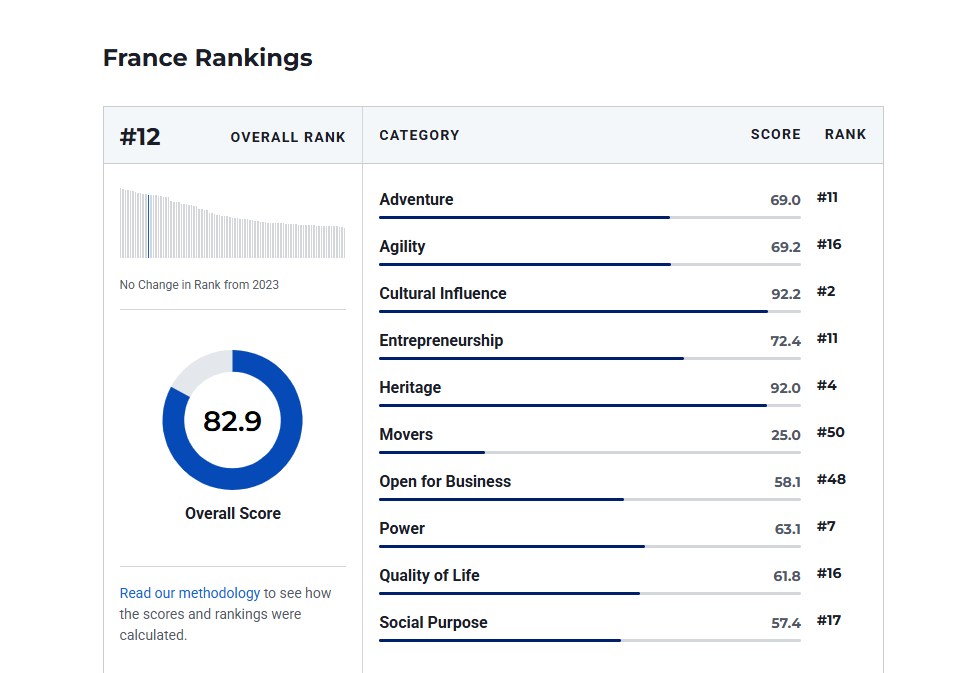
- Capital: Paris
- Region: Europe
- GDP (PPP): $3.03 trillion
- GDP Per Capita (PPP): $61,157
- Population: 68,170,228
- Area: 643,801 sq. km
- Economic Power: France's economy ranks 7th globally with a GDP of $3.28 trillion and PPP GDP of $4.49 trillion. It excels in aerospace, luxury goods, and tourism, with a GDP per capita (PPP) of $65,626. Services dominate, making up nearly 79% of the economy.
- Military Strength: France maintains a modern military with a $46B+ defense budget, nuclear capabilities, and global reach. It operates Rafale jets, Leclerc tanks, and nuclear submarines, and is developing a next-gen aircraft carrier. France is active in NATO and Indo-Pacific security operations.
- Technological Advancements: France leads in aerospace, nuclear energy, and AI. Home to Airbus and ArianeGroup, it invests in quantum computing and cybersecurity. Institutions like CNRS and INRIA drive innovation, while Paris fosters a vibrant tech start-up ecosystem and smart city initiatives.
#8. Japan

- Capital: Tokyo
- Region: Asia
- GDP Per Capita, PPP: $50,207
- GDP: $4.21 trillion
- Population: 124,516,650
- Area: 377,915 Sq. Km
- Economic Power: Japan's economy ranks 4th globally with a GDP of $4.21 trillion and a PPP GDP per capita of $50,207. It excels in automotive, electronics, and robotics, with a strong focus on high-tech manufacturing. Services also play a significant role, contributing substantially to its economic output.
- Military Strength: Japan maintains a highly advanced and well-equipped self-defense force, with a substantial defense budget. It operates cutting-edge destroyers, submarines, and fighter jets, including the F-35. While constitutionally limited to self-defense, Japan actively participates in international security dialogues and exercises, especially in the Indo-Pacific region.
- Technological Advancements: Japan is a global leader in robotics, automotive technology, and consumer electronics. It boasts world-renowned companies like Toyota, Sony, and Fanuc, and is at the forefront of developing advanced AI, smart city solutions, and sustainable energy technologies. Research institutions and corporate innovation drive its progress in diverse fields, from high-speed rail to advanced materials.
#9. Saudi Arabia

- Capital: Riyadh
- Region: Middle East
- GDP Per Capita, PPP: $54,992
- GDP: $1.07 trillion
- Population: 36,947,025
- Area: 2,149,690 Sq. Km
- Economic Power: Saudi Arabia's economy is a significant global player, with a nominal GDP of approximately $1.06 trillion (2023) and a PPP GDP reported at around $1.83 trillion in 2023. Its GDP per capita (PPP) was around $62,676 in 2024. While historically heavily reliant on its vast oil and gas reserves, which remain the backbone of its economy, contributing significantly to government revenue and exports, Saudi Arabia is actively pursuing economic diversification under Vision 2030.
- Military Strength: Saudi Arabia maintains one of the largest defense budgets globally, allocating approximately $78 billion for defense spending in 2025. This makes it the fifth-largest defense spender worldwide and the largest in the Arab world, representing about 7.1% of its GDP. The Kingdom is a significant importer of advanced military equipment and is actively working towards localizing 50% of its defense spending by 2030 through initiatives like the General Authority for Military Industries (GAMI).
- Technological Advancements: Saudi Arabia is making substantial investments in technological advancements and innovation, aligning with its Vision 2030 goal of building a knowledge-based economy. The Saudi Data and Artificial Intelligence Authority (SDAIA) is spearheading efforts in AI, aiming to train one million Saudis in AI skills and integrating AI across various sectors like healthcare, transportation, and finance. Major projects like NEOM, a futuristic megacity, are designed to incorporate cutting-edge technologies, including AI, robotics, and renewable energy, at an unprecedented scale.
#10. Israel
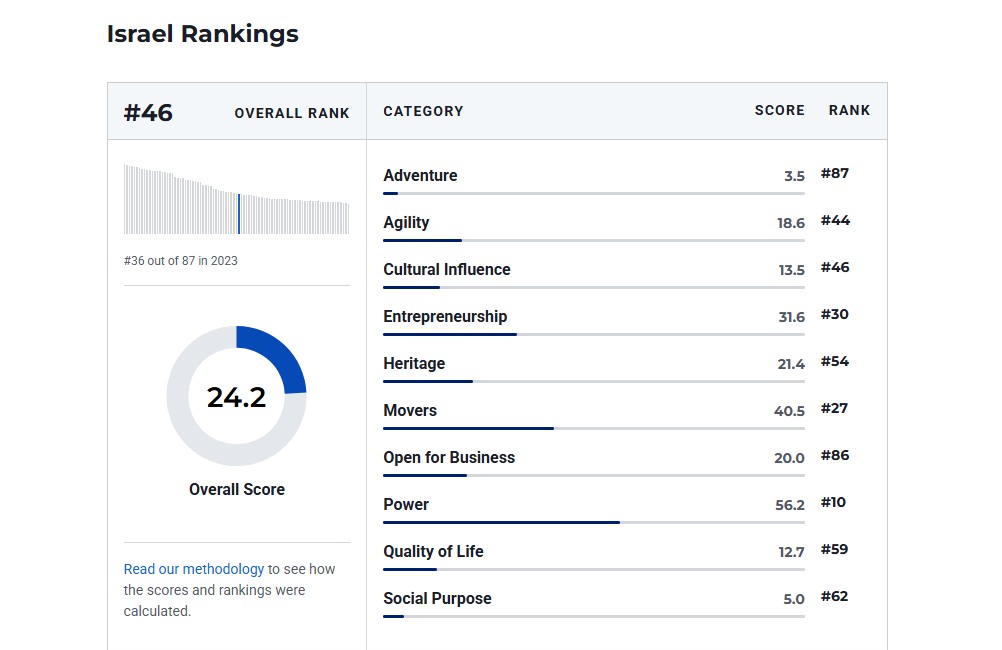
-
Capital: Jerusalem
-
Region: Middle East
-
GDP Per Capita, PPP: $53,434
-
GDP: $510 billion
-
Population: 9,756,700
-
Area: 21,937 Sq. Km
- Economic Power: Israel boasts a highly developed and advanced economy, ranking among the top countries globally in terms of foreign-exchange reserves and wealth per adult in the Middle East. With a nominal GDP of approximately $513.6 billion (2023) and a PPP GDP of around $471.6 billion (2023), its GDP per capita (PPP) is estimated at $47,866 (2024). High-technology and industrial manufacturing are the primary economic sectors, with services dominating at nearly 72.4% of the economy. Israel is often referred to as the "Silicon Valley of the Middle East" due to its robust innovation ecosystem.
- Military Strength: Israel maintains a highly modern and capable military, the Israel Defense Forces (IDF), with a significant defense budget of approximately $24.3 billion (2021). The IDF comprises ground forces, air force, and navy, and is believed to possess operational nuclear weapons capabilities. It fields advanced equipment such as Merkava tanks, Rafale jets (though primarily using F-15s, F-16s, and F-35s), and nuclear submarines. Israel is particularly known for its missile defense systems like the Iron Dome, David's Sling, and Arrow, and actively engages in research and development cooperation with partners like the United States.
- Technological Advancements: Israel is a global leader in technological innovation, often called the "Start-up Nation." Its advancements span numerous fields, including cybersecurity, medical technology, aerospace, and agricultural technology. Notable Israeli inventions and developments include the USB flash drive, the PillCam (swallowable medical camera), Mobileye (driver-assistance technology), and drip irrigation systems (Netafim). Israeli institutions like the Weizmann Institute of Science, Technion, and various universities drive cutting-edge research in areas such as quantum computing and artificial intelligence.
12. India

-
Capital: New Delhi
-
Region: Asia
-
GDP: $3.55 trillion
-
GDP Per Capita (PPP): $10,176
-
Population: 1,428,627,663
-
Area: 3,287,263 sq. km
-
Economic Power: India ranks fifth globally by nominal GDP ($3.55 trillion) but third in PPP terms ($10.176 trillion). Its economy is driven by IT services (e.g., Infosys), manufacturing (e.g., Tata Group), and agriculture. Startups in fintech and e-commerce are growing rapidly.
-
Military Strength: India has one of the largest armies globally and nuclear capabilities. It is modernizing its forces with indigenous defense technologies like fighter jets (Tejas) and ballistic missiles (Agni series).
-
Technological Advancements: India excels in IT services and space exploration through ISRO (e.g., Chandrayaan missions). It is investing heavily in digital infrastructure and AI development.
What Makes a Country Powerful? The 7 Pillars of Global Power Explained
The power of a nation on the global stage is determined by various key factors that extend beyond military might. These drivers collectively shape its influence, economic dominance, and geopolitical strength. Here are the seven crucial drivers.
1. Economic Strength
Economic power is a fundamental pillar of global influence. It determines a nation’s ability to invest in infrastructure, technology, education, and defence.
A robust economy allows countries to exert influence in global markets, shape international trade policies, and provide aid to other nations, thereby securing alliances.
Economically dominant countries like the United States and China are home to leading multinational corporations, dominate financial markets, and set global economic trends.
For example, China's Belt and Road Initiative showcases how economic strength can expand a nation's influence by creating dependence through infrastructure investments worldwide.
2. Military Capabilities
A powerful military provides both defence and deterrence. Nations with strong military capabilities can protect their borders, project power abroad, and influence international conflicts or peacekeeping efforts.
The U.S. maintains over 750 military bases globally, ensuring its presence in key regions. Modern military power also includes cyber defence, space capabilities, and advanced weaponry.
Countries like Russia and China invest heavily in these areas, challenging the traditional dominance of Western nations.
Military alliances, such as NATO, further amplify a country's strength by pooling resources and ensuring collective security.
3. Technological Innovation
Technology is a driving force behind modern global power. Nations leading in areas such as artificial intelligence, quantum computing, biotechnology, and renewable energy gain strategic and economic advantages.
For instance, the U.S. dominates global tech innovation with companies like Google and Microsoft, influencing global communication and security.
Technological prowess also enhances military capabilities as seen in advancements in drones, satellites, and cybersecurity.
China's rapid technological advancements, such as its strides in 5G and AI, have positioned it as a key competitor on the global stage.
4. Geopolitical Influence
Geopolitical influence is shaped by a country’s strategic location, natural resources, and ability to navigate international relations.
For example, Saudi Arabia’s control over vast oil reserves makes it a critical player in global energy markets.
Similarly, nations like Turkey and Singapore leverage their geographic locations to influence trade routes and regional politics.
Control over chokepoints such as the Strait of Hormuz or the South China Sea enhances a nation’s strategic importance.
Countries with geopolitical influence can mediate conflicts, negotiate favourable trade terms, and lead in multilateral organisations.
5. Diplomatic Network
Diplomacy amplifies a country's ability to influence international affairs without direct conflict. Through alliances, treaties, and participation in global institutions, nations can foster cooperation and resolve disputes.
The United Nations, NATO, and G20 are platforms where diplomatic prowess is showcased. Soft power, including cultural exports and ideological appeal, also plays a crucial role.
For instance, France’s cultural diplomacy and India’s focus on yoga and Bollywood enhance their global reputations.
A strong diplomatic network allows countries to shape global narratives and establish leadership in global governance.
6. Human Capital
The quality and education of a population directly affect a country's productivity and innovation. Nations with skilled workforces attract global investments and maintain competitive economies.
Germany's focus on vocational training and Japan's emphasis on technological education are examples of leveraging human capital for sustained growth.
Human capital also influences technological innovation and adaptability in a rapidly changing world.
Countries with robust healthcare and education systems ensure a healthier, more capable workforce, further bolstering their economic and global standing.
7. Cultural and Ideological Influence
Cultural dominance enables nations to shape global perceptions and values. The U.S., through Hollywood, fast food, and social media, has entrenched itself in the cultural psyche of the world.
Similarly, countries like South Korea leverage pop culture (e.g., K-pop) to expand their global influence. Ideological appeals, such as promoting democracy, human rights, or sustainability, can also attract allies and shape international norms.
Countries with strong cultural influence often enjoy goodwill, making their policies and products more acceptable globally.
How These Factors Declare a Country Most Powerful?
- Interdependence: Each factor strengthens the others. Economic power funds military and technological advancements. Cultural influence attracts allies, enhancing diplomatic networks.
- Global Impact: Countries like the U.S. and China demonstrate how combined factors ensure dominance in international organisations, trade, and geopolitical conflicts.
- Sustainability: Long-term influence relies on maintaining a balance across all factors, ensuring resilience in global competition.
Comments
All Comments (0)
Join the conversation